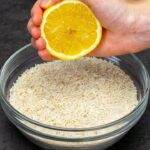Leftover rice, if not reheated properly, can cause health issues due to the presence of Bacillus cereus, a bacterium commonly found in rice and rice products when left at room temperature for too long. This bacterium produces toxins that lead to food poisoning, resulting in nausea, vomiting, abdominal pain, and diarrhea.
How to properly reheat leftover rice?
Proper reheating of leftover rice not only warms it but also retains its taste, destroys harmful bacteria, and ensures food safety for your family.
Using a rice cooker

Properly reheat leftover rice in a rice cooker: Sprinkle a little water on the rice to create moisture and make it softer. (Photo: OvenSpot)
A rice cooker is the most common and convenient appliance for reheating leftover rice. This method is preferred by many due to its simplicity and speed.
– Place the leftover rice in the rice cooker: Spread the rice evenly so that it heats up uniformly and quickly. Sprinkle a small amount of water on the surface of the rice. You don’t need a lot of water, just one or two teaspoons to create moisture and make the rice softer.
– Press the “Cook” button and wait for about 5-10 minutes, depending on the amount of rice. Once the rice is heated and steaming, you can switch to the “Warm” mode if you’re not serving it immediately.
Note: Avoid keeping the rice in the “Warm” mode for too long, as it may dry out the rice or alter its natural flavor.
Reheating leftover rice in a microwave
A microwave is an excellent choice for quickly reheating rice, especially when you only need a small portion.
Place the leftover rice in a microwave-safe bowl or container. Sprinkle a little water to prevent the rice from drying out. You can cover the bowl with a damp cloth or plastic wrap (ensure the plastic doesn’t touch the rice) before placing it in the microwave and turning it on.
Heat the rice on high power for about 1-2 minutes, depending on the quantity. Then, check if the rice is hot enough. If not, continue heating for another 30 seconds.
Note: Keeping the rice covered while reheating in the microwave helps retain moisture and makes the rice softer.
Using a steamer
This method ensures even heating and preserves the original flavor of the rice. Boil water in the steamer, place the leftover rice in a tray, cover, and steam for about 10 minutes or until the rice is evenly heated. For added flavor, steam the rice with pandan leaves or sprinkle a little sesame oil.
Reheating leftover rice with freshly cooked rice
If you’re cooking fresh rice, you can reheat the leftover rice at the same time. Once the fresh rice is cooked, use a spoon to push it to one side and add the leftover rice to one corner of the pot. Do not mix the freshly cooked rice with the leftover rice. Only fluff and mix them together once the leftover rice is thoroughly heated.
Notes on reheating leftover rice
– If you can’t finish the rice in one meal, divide it into smaller portions and let it cool before storing it in the refrigerator. Leftover rice should be consumed within 24 hours of cooking and should not be left at room temperature for more than 2 hours to prevent bacterial growth.
– Leftover rice should only be reheated once after cooking. Repeated reheating not only reduces the quality but also increases the risk of food poisoning.
– When reheating, ensure the rice reaches a temperature of at least 74°C to destroy harmful bacteria. You can use a food thermometer to check the temperature if needed.
By following these simple methods, you can always enjoy hot, delicious, and nutritious rice meals.
According to VTC News



































